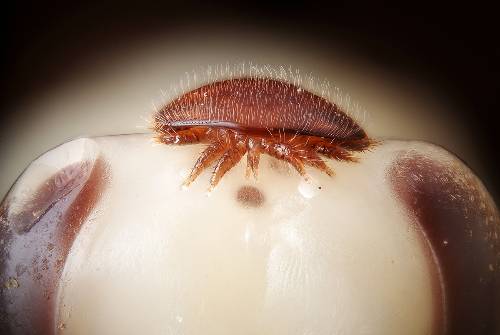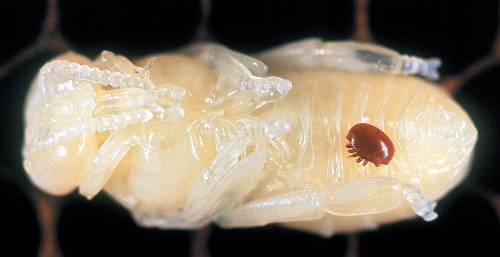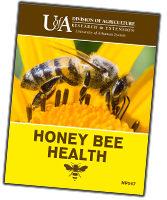
Fighting the Mites
The beekeeping industry is plagued with many challenging issues these days, including parasites and pathogens, poor nutrition due to habitat loss, and pesticides and other pollution. And despite the large amount of media attention focusing very narrowly on pesticide issues, the parasitic mite Varroa destructor remains the biggest problem for honey bees and beekeepers around the world. This tiny critter is one of the largest parasites known to science, when compared to the size of it's host body. To a 3/4" long honey bee, this 1/16" mite is a big deal.

(flickr.com/photos/sanmartin/5048727154/in/photostream)
These mites are bad news for our bees. And the viruses they vector are also bad news. But the mite-virus complex is really worse than the sum of it's parts. A varroa mite causes physical damage to the bee when it feeds, but it also significantly impairs a bee's immune system while simultaneously spreading viruses and other pathogens. Much of the damage done to the bee happens during its pupal development, when it is sealed up inside a honeycomb cell, undergoing a complete bodily reorganization known as metamorphosis. The deleterious damage done by mites and pathogens at this stage can profoundly affect metabolic processes that cascade throughout the bee's short life.

(scienceimage.csiro.au/image/7014)
Honey bees can range up to several miles from home while foraging for nectar and pollen. It's a dangerous world out there for a lone bee far from home. While there may be little that a beekeepers can do to mitigate these dangers beyond their own back yards, taking the fight to the mite is one thing we can do at home.
And yet, many beekeepers choose to do nothing.
I often receive calls from other beekeepers (or county agents calling on behalf of beekeepers) wanting help to diagnose why some bee colonies are failing. I will always ask, "Have you checked your mite levels?" And sadly, most of the time, the answer will be, "No."
This is like going to your dentist and saying, "No, I don't brush my teeth. Now tell me why they are falling out!"
Checking for mites is not difficult or time consuming, and it does not require investing in expensive specialized tools. You can use a standard canning jar with a piece of screen to collect your bees. A spoonful of powdered sugar will dislodge the mites from the bees. You simply shake the sugar and mites though the screen to take a count. It only takes a few minutes to check and it won't harm your bees. And the information you gain from this is very valuable for your colony management. This video from the LSU AgCenter show how easy it is to count mites.
There are other tools and techniques available to test for mites, using alcohol (which is fatal to those bees) or CO2 (which requires extra equipment). But the important thing to know is what to do with the numbers you get. To make sense of that mite number, you need to be able to calculate the infestation level in a hive, which we give as "mites per 100 bees" or "percentage infestation."
A 1/2 cup scoop contains roughly about 300 bees. If you use this sample size every time, you can count the mites and do the math, and your sampling will be consistent, and you can compare results throughout the season and from hive to hive.
For example, if you took a sample of 300 bees and found 9 mites you would have a 3% infestation level.


Experts advise beekeepers to maintain varroa mite levels below 3% infestation all season long. If your colony's mite level exceeds this threshold, then intervene. The problem will get worse on it's own, not better.
If a colony begins to collapse because of high varroa mites, the mites will spread to other colonies. Sometimes the mites spread on bees that leave a dying colony and "drift" to a healthy one, bringing their problems with them. Sometimes healthy colonies will rob the honey from weak colonies, bringing home mites as well as free food.
Beekeepers have a number of options to fight varroa, but unfortunately none of them are perfect. The best approach to keeping hives healthy is to develop an Integrated Pest Management (IPM) strategy for your operation. Consult our MP-547 publication, available from your County Extension Office or free to download. This handy publication discusses different mite sampling protocols and treatment options in detail.
For specific pesticide or treatment products for varroa mites or other bee hive pest and disease problems, consult our MP-144 publication. This book is updated each year with the most current recommendations for bee hives and just about any other arthropod pest that's bugging you.
Fall is here. If you keep bees and don't know what your colony's mite levels are, then don't wait! This should have been done soon after you have harvested the last of your honey, and treatments made. If you delay too long, your bee colonies will go into winter with sick, weak bees. Weaker colonies will be less likely to survive the winter and build up into productive spring colonies next year.
So brush your teeth and visit your dentist regularly for healthy teeth and gums. And check on your honey bees too, to help them stay healthy and productive.